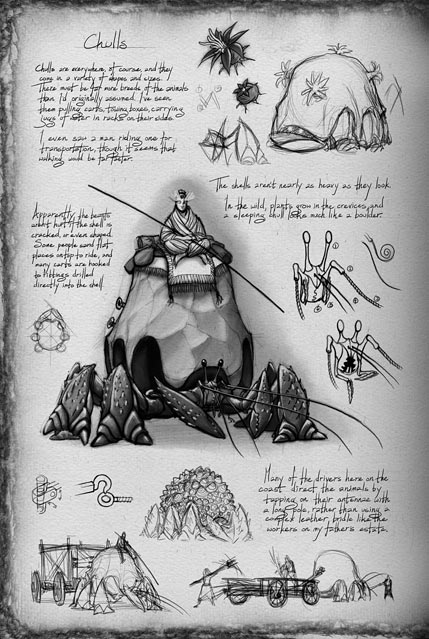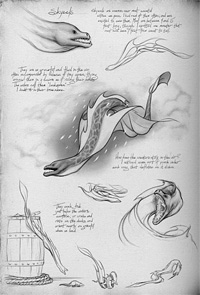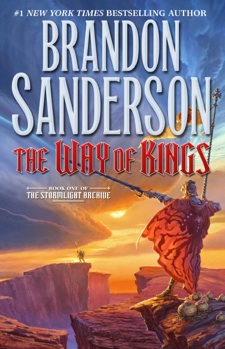Brandon Sanderson has often said (and I have quoted ad nauseam) that any author who grew up on Robert Jordan has a great epic of their own to tell. Without a doubt, The Way of Kings is Brandon’s. We have grand battles, both arcane and new magics, compelling characters, and a strange new world called Roshar.
What really strikes me the most about The Way of Kings is how different it is from Brandon’s other work. I’ve read Elantris, the Mistborn Trilogy, and Warbreaker, and this is really nothing like any of those. Of course, on closer inspection, this is also the first novel Brandon has written cover to cover since he took on the Wheel of Time.
Which of course might make one think that I’m about to say this reads like a Robert Jordan novel. To the contrary, despite Brandon’s concept of scope being on par with Jordan’s, this is quite a bit different. We have no simple farmboy to follow out into the world, but instead three savvy (in their own rights) characters already dealing with a world wracked with war and intrigue.
And the world does indeed feel vast. Aside from the two major locations of action—which are spaced massively apart—we see numerous glimpses all over the world in the interludes, where several one-shot characters and one repeating (but only in the interludes) character take us around the world and give us worldbuilding we need for the story in an almost short story-like format.
Alas, this isn’t a completely glowing review. I would feel that I lacked due diligence if I did not warn of a simple thing: this book is nearly overwhelming. Clocking in at a hefty 1001 pages (in the advance reader’s copy version), there is a lot going on here: several styles of magic, more races than you can shake a Shardblade at, and a world with an ecosystem unlike any that I’ve read before. While all of these elements are wonderfully pulled off, altogether they start making you ask “who went where with the what?” The illustrations help a lot, but my advice: don’t start reading this without a lot of mental focus to devote to it. The book is a fun read, but hardly casual.
Also, the two main plots, while related and actually occasionally even interacting, have two very different climaxes and resolutions, and it is a good thing this book starts off clearly stating that it is a “Book One.” So yeah, if I have any gripe, it is that this book doesn’t even begin to say “yeah, I could stand on my own.” Conversely, the book does deliver and makes me want to read the next.
In short, bravo, Mr. Sanderson, and well played. You now have three books forthcoming that I am frothing at the mouth for (the other two being The Wheel of Time, of course).
TO MY COMMENTORS: Please be kind enough to say whether or not your comment has spoilers in it. That way, if someone wants to peruse the comments, they can know. Shame we don’t have a “hidden quote” feature. Ah well.
AND NOW, SPOILERS!

I am going to say one thing up front, though. This book has a lot going on in it. A LOT. I am typically a very meticulous reader (it took me about a week of hard reading to get through The Way of Kings), but I am sure there are things I have missed or was confused by. I welcome any and all to correct me, although I will go ahead and in advance say I’m not going to edit the post either. These are the thoughts I took away after reading the book.
Plot Thread: Kaladin
The marketing blurb on the back of my review copy unabashedly referenced Ben Hur when talking about Kaladin. Boy, was marketing right. Kaladin’s plot by itself is a book. In a disjointed order, we find out that Kaladin is a doctor’s son who enlists to protect his brother who is drafted, fails, kills a mega-magical-knight, refuses to become one himself, then becomes a slave. From there he works his way up while learning that he is a magician who can harness the magical Stormlight. His final climax, where he regains his self-confidence and honor by saving Dalinar, was made of as much awesome as such a scene should be and was honestly the most satisfying of the book’s climaxes. Of course, as Kaladin is the single character to get Points of View through every section, I would hope so. Sadly, the fact that his plot is tied to Dalinar’s kind of made his satisfying climax fall short.
Plot Thread: Dalinar
Dalinar is an interestingly written character, both strictly in plot and also in his circumstances. He is a politician and a general, but he is likely going insane. His plot mostly revolves around him trying to find a way to end the war with the people who killed his brother, but honestly, this plot never really gets off the ground. With how the story was paced, I was expecting a crushing victory for the Alethkar armies, but instead it ends with a betrayal by a person who had a third, even deeper layer that was the same as their first (like with pie). Granted, due to Kaladin saving Dalinar in the end, Dalinar now has the power to pursue and possibly end the war, but the whole thing almost reeked of a phantom menace. Yes, that Phantom Menace. Martial maneuvering for a person to gain political power. I don’t think anyone involved was a Sith Lord, per se, but Sadeas, the betrayer, comes pretty close. And he does sort of get a lightsaber out of it. All in all, Dalinar’s conclusion left me wanting more out of all the viewpoint characters, and not in a “when’s the next book coming out” sort of way.
Plot Thread: Shallan
Shallan’s climax was much better, if completely unrelated to the rest of the book. (Wow, did I just write that?) Okay, she is with the king’s sister trying to steal her magical transmutation device, the Soulcaster. (Not helping!) She even succeeds, almost leaves, then is poisoned and nearly killed by her love interest and then saved by said sister. (I…oh nevermind.) The way it wraps up actually makes me happy, but the other questions left me annoyed. What is up with the “symbol-spren” who give people the power to soulcast without a Soulcaster? Why does Shallan have a Shardblade, and what exactly happened the night her father died? Unlike in Kaladin’s plot, where questions like this taunt us from the first pages and are finally answered, Shallan’s never are. (She’s a tease?) That is acceptable, I guess, but I would have liked just a little more meat from her past. Oh, and I am also totally calling red herring on the Parshman-Voidbringer theory. It fits too well, and Brandon did grow up reading Jordan.
Plot Threads Overall
Overall, I am actually pretty happy with the plot. It was a little, um, epic? Yeah, epic for a first novel. I remember in a writer’s track session with Brandon at JordanCon that he spoke on how it is important to ease a reader into the world, usually with a naïve person the reader can sympathize with. We didn’t get that, but really all it means is that we have to be a little more attentive while reading. The interludes give us important backstory or worldbuilding that would have been clumsy in the main plots, although I will admit they are sometimes a little blunt or quick in providing the information just in time for it to be useful for us in the main plot.
Worldbuilding: Magic
Okay, moving on. Let me list out the magics, just as I can count them off the top of my head:
Shardplate and Shardblades: Which may or may not be unique in their style.
Fabrials: Science-like devices that use Stormlight.
Soulcasters and soulcasting: The first being a special fabrial that allows anyone to do the second, which some people can do with just raw gems. Basically the ability to transmute things.
Surgebinding: the ability to take Stormlight into the body, strengthening it, and then being able to redirect it into the Lashings, which, um, make things stick together. Kinda.
Spren: Magical beings that associate to things, such as flamespren, windspren, honorspren, fearspren, deathspren, etc. They can bind to a human to make him a Surgebinder.
The Old Magic: Some strange magic system hidden in a valley somewhere that gives you a blessing and a curse. Dalinar can’t remember his wife because of this. (Oddly, that is the blessing.)
Now, yes, all of these are connected via the Stormlight, but at the same time, fabrials are basically science, but Soulcasters, Shardplate, and Shardblades are all ancient, irreplaceable, and oddly unique in what they do. Magical, even. Surgebinding is all but forgotten, except for Szeth, and seems to have nothing to really do with the others. The spren don’t even really seem to have anything to do with the magics, except that they can apparently make someone into a Surgebinder. And the Old Magic is just out of left field, really. As I said above, these are all well-created magics. But especially when we got to the Old Magic, I will admit I rolled my eyes and thought “Another magic system?”
Worldbuilding: Races
If it is one thing Roshar has, it is a lot of people. And not just “people.” I cannot even begin to remember all of the types of humans, but it was as many as there were countries. Apparently blood does know nationality, and at a glance you can tell where a person is from, be it a Horneater, a Thaylen, a Jah Kevedan, a Parshman, or any numerous others. We are talking some people have blue or red skin, some have dangling, droopy eyebrows, or sometimes they just have crazily colored hair. I found it interesting, but I can’t help but admit the hidden biologist in me wondered how well they could intermarry. It is implied that four nations have some shared blood, but the world has far more than that. I almost feel bad, though, because at the end of the day, it almost just feel like all of the races were becoming a “planet of hats.” Especially when it turns out that each nation has a “national job,” such as Parshmen being mindless servants, Thaylens being traders, Horneaters are cooks, and Athelkar is full of warriors.
Worldbuilding: Roshar’s Ecosystem
Brandon does everything he can to take us away from the familiar with this world. Only one small section of the world has topsoil and a “traditional” ecosystem. The rest of the world is made of stone as soil is unable to withstand the forever westward-blowing highstorms. Giant crab-like creatures are used like oxen, mud falls from the sky, and numerous strange beasts inhabit a world where the only familiar creature besides a human is a horse, and those are rare. I’m going to admit, all the talk of rockbuds and cremlings kind of bogged me down, but it was interesting. Sadly, much like the old joke about Robert Jordan spending two pages describing the bushes around the Winespring Inn, I fear that the sheer amount of time Brandon has to spend on realizing his world to us will be off-putting to all but the most entrenched of epic fantasy fans. In short, this is definitely not a book to suggest to a friend new to speculative fiction.

Worldbuilding: Illustrations
One thing I didn’t talk about much in the spoiler-free part was the illustrations. Part of the reason is that I haven’t seen half of them. Yeah, I’ve read the book, but the advanced copy I was given was fraught with blank pages and notes of what was supposed to be there. What I did get to see, though, thoroughly enhances the story and even made the last point easier to handle. Shallan is a naturalist, after all, and her sketches of animals and the like are part of the illustrations I did get to see, at least. Likewise, Navani’s notebooks were interesting not only in letting us see how fabrials were thought of by someone who made them, but they also let us see what the soundwave-like written language of the world was like too.
Layers (like an onion or a cake)
The illustrations naturally segue to my next thought: this is a book to be traversed, not just read. I was about three-quarters of the way through before I realized there was more to the chapter headings than just the changing icon. No, the faces in the framer were changing too. What do they mean? I don’t know. I tried to start coming up some ideas, but I was so busy with other things on my mind, it was a little numbing. Granted, this isn’t as bad a brain-mush-maker as House of Leaves, but between the layers of the illustrations, the plots, the worldbuilding hidden in the interludes with what will probably turn out to be important actions later, and very way the world is built, it is a lot to take in.
In Comparison to Brandon’s Other Books
Hold that idea for a moment. Now then, one thing I really want to talk about some more is how this book is different from anything else Brandon has written. Small story time: I read Elantris after The Way of Kings. This also means after Mistborn and Warbreaker, let alone The Gathering Storm. As I read Elantris, I was actually chuckling at how much of Warbreaker and Mistborn I saw in them. A small group of nobles trying to overthrow a tyrant king, a conspiracy out of left field that needs stopped, and this feeling of multiple god-like beings giving magic to a people. Of course, those gods are the Shards of Adonalsium, which are mentioned by name in The Way of Kings, and I won’t bore you with much on them except to point you to Brandon’s forums where they are discussed.
But, what I’m getting at here is that The Way of Kings is very unlike Brandon’s other writing. That this was written after he has grown as a writer in the writing of The Wheel of Time is obvious. The writing just has a more epic feeling to it without being over the top, and he has moved past his original comfort zones. The action takes place in more than just a single city, to the point that I do feel like this is going on in a world. Mistborn was starting towards that in the third book, but that still really felt like just a large city, not a world. Roshar is a world, no doubt. I am somewhat worried that Brandon might have gone too far, though.
Because it gets down to what I said in the spoiler-free free part. There is almost too much here. (Yes, you can stop holding the idea from above.) I am undoubtedly going to need to read the book again several times before I’m comfortable with what there is to know about Roshar, and even then, I feel somewhat daunted by the hint of what I don’t know. Perhaps if I had the actual world map (which was absent) or the other half of the illustrations, I wouldn’t be wondering as hard, but I don’t think so. I heard Brandon say this is supposed to be book one of ten, and he can hardly give it all up in the first. I just, oddly, wish there had been less forshadowing. Is that strange? Perhaps it is more that I wish there was less obvious foreshadowing.
Final Thought
This is a great book. It is just not an easy book. Give it time, don’t skim, and don’t be afraid to go read some threads over in the fan communities, such as Stormblessed. I think the Stormlight Archives are, all-in-all, off to a great start and I look forward to the next one, even if I know I need to read this one again before I can read that one. Fortunately, it will be a bit before we see said next one, so at least I have time.
Richard Fife is a writer, blogger, and working on a Stormlight-powered device to go into the future so he can read the books already. He may or may not also be a chull in disguise. You can read more of his ramblings and some of his short fiction at http://RichardFife.com.










